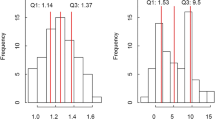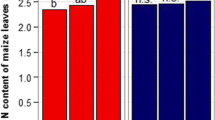Abstract
The response of sole and intercropped cereal to nitrogen fertilization was compared in three contrasting cropping systems, sorghum/pigeonpea, maize/groundnut, and sorghum/cowpea. The cereal in these systems responded to nitrogen similarly as in sole cropping, although different legumes affected the cereal differently. There was no current season benefit from the legume, whether it matured earlier or later than the cereal, and for high yields the cereal in intercropping needs fertilizer application. Response to nitrogen varied with the amount and distribution of seasonal rainfall. With increased nitrogen fertilizer applied to the intercropped cereal, the legume yields were suppressed. The optimum dose for the intercropped cereal was similar to that for sole cropping but it was 50% less in a dry year particularly, on a shallow Alfisol. The combined yields of both crops made intercropping more profitable than sole cropping. The relative advantage of intercropping was high in the sorghum/pigeonpea system (40 to 70%) because of the greater temporal difference between species, and moderate in the maize/groundnut (13 to 35%), and sorghum/cowpea (18 to 25%) systems. Although the relative advantage of intercropping (expressed as Land Equivalent Ratio (LER)) decreased with N, the economic value, of the advantage was little affected within the optimum N range because absolute yields increased with fertilization.
Similar content being viewed by others
References
Ahmed S and Gunasena H P M 1979 N utilization and economics of some intercropped systems in tropical countries. Trop. Agric. (Trinidad) 56, 115–123.
Ahmed S and Rao M R 1982 Performance of maize-soybean intercrop, combination in the tropics: Results of a multilocation study. Field Crops Res. 5, 147–161.
De R, Gupta R S, Singh S P, Pal M, Singh S N, Sharma R N and Kaushik S K 1978 Interplanting maize sorghum and pearl millet with short-duration grain legumes. Indian J. Agric. Sci. 48, 132–137.
Eaglesham A R J, Ayanaba A, Ranga Rao V and Eskew D L 1981 Improving the nitrogen nutrition of maize by intercropping with cowpea. Soil Biol. Biochem. 13, 169–171.
Feeraz Gominho M S and Mafra R C 1979 Uma metodologia de analise agroeconomica para culturas consorciadas em expermientos de adubação Pesq. agropec. Pernamb. Recife 3, 161–182.
Nambiar P T C, Rao M R, Reddy M S, Floyd C N, Dart P J and Willey R W 1983 Effect of intercropping on nodulation and N-fixation by groundnut. Expl. Agric. 19, 79–86.
Natarajan M and Willey R W 1980 Sorghum-pigeonpea intercropping and the effects of plant population density. 1. Growth and yield. J. Agric. Sci. Cambridge, 95, 59–65.
Rao M R and Willey R W 1980 Evaluation of yield stability in intercropping: studies on sorghum/pigeonpea. Expl. Agric. 16, 105–117.
Reddy M S and Willey R W 1981 Growth and resource use studies in an intercrop of pearl millet/groundnut. Field Crops Res. 4, 13–24.
Remison S U 1978 Neighbour effects between maize and cowpea at various levels of N and P. Expl. Agric. 14, 205–212.
Rewari R B, Sen A and Pandy S L 1972 Excretion of nitrogen from the roots of guarbean,Cyamopsis psoralioides. J. Indian Soc. Soil Sci. 5, 237–245.
Ruschel A P, Salati E and Vose P B 1979 Nitrogen enrichment of soil and plant byRhizobium phaseoli Phaseolus vulgaris symbiosis. Plant and Soil 51, 425–429.
Santa Cecilia F C, Ramalho M A P and Garcia J C 1982 Abubação nitrogenada e fostatada na consorciação milhofeizao. Pesq. Agropec. bras., Brasilia 17, 1285–1291.
Singh S P 1981 Studies on spatial arrangement in sorghum/legume intercropping system. J. Agric. Sci. Cambridge 97, 655–661.
Virtanen A I, Von Hausen S and Laine T 1937 Investigation on the root nodule bacteria, of leguminous plants. XX Excretion of nitrogen in associated cultures of legumes and nonlegumes. J. Agric. Sci. 27, 610.
Wahua T A T and Miller D A 1978, Effects of intercropping on soybean N fixation and plant compilation on associated sorghum and soybeans. Agron. J. 70, 292–295.
Willey R W 1979 Intercropping — its importance and research needs. I. Competition and yield advantages, II. Agronomy and research approaches. Field Crop Abstr, 32, 1–10, 73–85.
Wilson P W and Wyss O 1937 Mixed cropping and the excretion of nitrogen by leguminous plants. Soil Sci. Soc. Am. Proc. 2, 289–297.
Author information
Authors and Affiliations
Rights and permissions
About this article
Cite this article
Rao, M.R., Rego, T.J. & Willey, R.W. Response of cereals to nitrogen in sole cropping and intercropping with different legumes. Plant Soil 101, 167–177 (1987). https://doi.org/10.1007/BF02370641
Received:
Revised:
Issue Date:
DOI: https://doi.org/10.1007/BF02370641




